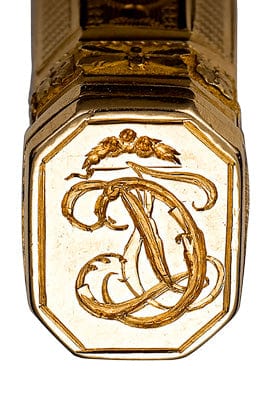
Petit, charming, and intimate. At first glance, an étui is certainly a mysterious, decorative object. Comprised of a small shaft-like shape, the object has two parts. With the gentle pull, the object pulls apart to reveal a small storage space. Taking their name from the French word, “estuier” meaning “to keep or hold,” the étui is a multi-functional objet d’art.
As a convenient vehicle for holding an array of small items, the étui has held multiple uses throughout history. In 13th century Italy, etuis were crafted of wood and wrapped in stiffened, chassed leather, often called cuir bouilli. A carrying strap completed the object for easy transportation. It is believed that these earlier etuis were made to carry writing tools, as similar cases are depicted in paintings of scholar’s studios.
Aristocratic and court culture in 18th-century France demanded all things luxurious. Simply put, one’s entire life would be comprised of fine materials, goods, and ways of life. Étuis, consequently, took on an entirely new, clandestine function. Court-goers and nobility discreetly pass notes to one another concealed within an étui. Frequently, an étui carrying a secret correspondence would be sealed with wax to ensure the utmost privacy. Other young woman would keep their sewing needs, scissors, thimbles, and even small hair combs tucked inside these diminutive works of art.

The 18th century was also the time in which the workmanship of the étui reached its zenith. The vehicle by which an artisan could display his technical prowess, The workmanship of each étui became as important as the function the object served. 18K gold in hues of yellow, white, rose and even green was the primary medium of choice. In France, the Louis XVI and Louis XV-styles proliferated and elaborate, ornate Neoclassical motifs were masterfully chased and etched over every serface of the étui. Often breathtaking hand-painted enamel genre scenes, precious jewels and even rare minerals would be employed to complete an étui’s design. Truly, the only limit was the craftsman’s imagination.








